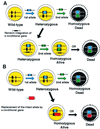Homologous DNA recombination in vertebrate cells
- PMID: 11459980
- PMCID: PMC37448
- DOI: 10.1073/pnas.111006398
Homologous DNA recombination in vertebrate cells
Abstract
The RAD52 epistasis group genes are involved in homologous DNA recombination, and their primary structures are conserved from yeast to humans. Although biochemical studies have suggested that the fundamental mechanism of homologous DNA recombination is conserved from yeast to mammals, recent studies of vertebrate cells deficient in genes of the RAD52 epistasis group reveal that the role of each protein is not necessarily the same as that of the corresponding yeast gene product. This review addresses the roles and mechanisms of homologous recombination-mediated repair with a special emphasis on differences between yeast and vertebrate cells.
Figures



References
-
- Reynaud C A, Bertocci B, Dahan A, Weill J C. Adv Immunol. 1994;57:353–378. - PubMed
-
- Arakawa H, Kuma K, Yasuda M, Furusawa S, Ekino S, Yamagishi H. J Immunol. 1998;160:4232–4241. - PubMed
-
- Baba T W, Giroir B P, Humphries E H. Virology. 1985;144:139–151. - PubMed
-
- Buerstedde J M, Takeda S. Cell. 1991;67:179–188. - PubMed
Publication types
MeSH terms
Substances
LinkOut - more resources
Full Text Sources
Other Literature Sources
Molecular Biology Databases
Research Materials

